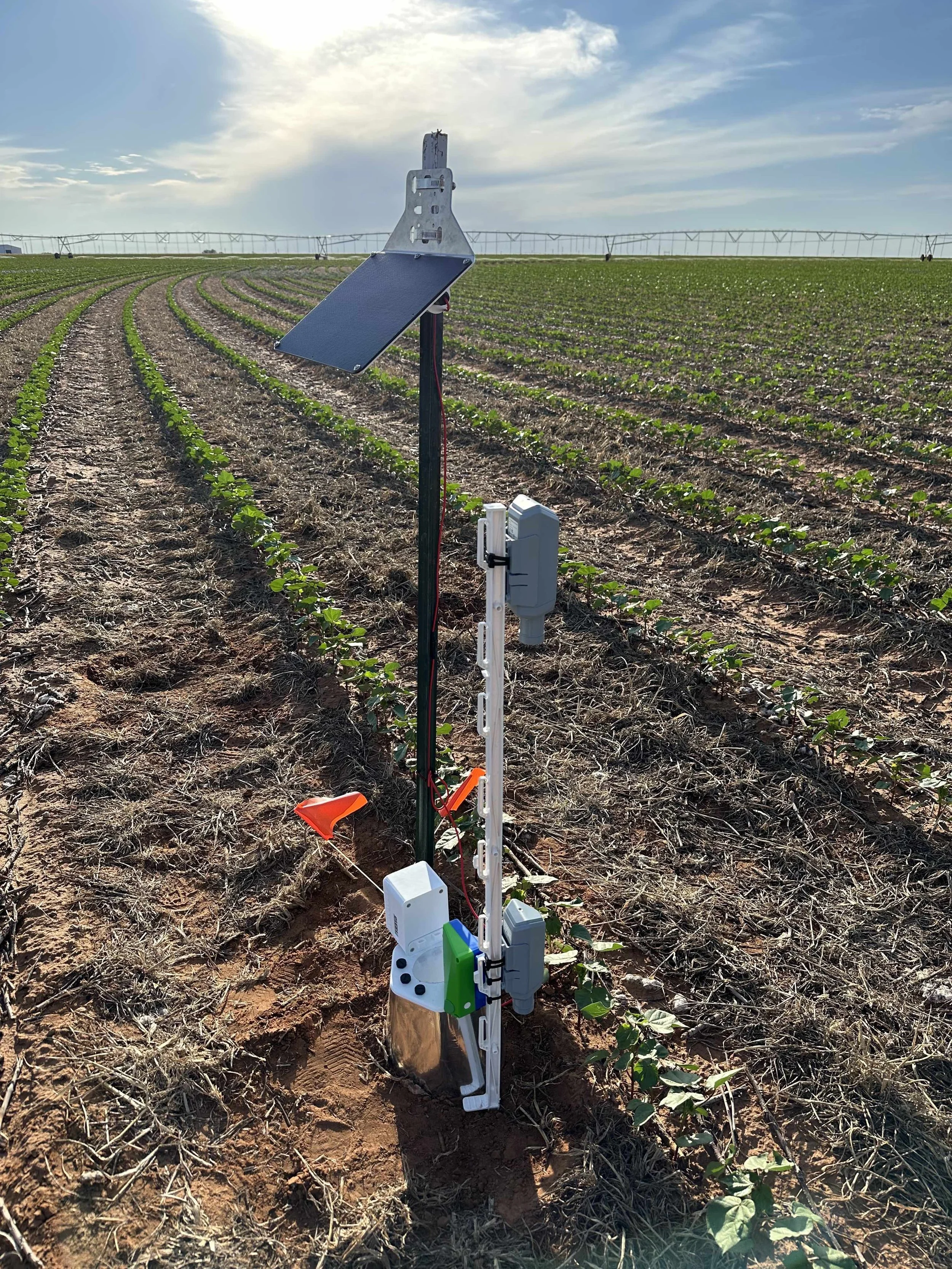Arbiter Carbon Monitoring System
Real-Time Monitoring of Net Carbon Flows to Optimize Ecosystem Regeneration and Soil Carbon Accrual
For a complete picture of ecosystem health while building healthy soils, growers and land managers can monitor flows of carbon and assess soil carbon stocks via Net Ecosystem Exchange (NEE) of CO₂. NEE illuminates how the soil carbon builds via photosynthesis, providing insight into the liquid carbon pathway, as well as the discharge of CO₂ via microbial metabolism of soil organic matter (soil respiration). NEE also illuminates, in real time, how weather, moisture and on-farm practices affect dynamic CO₂ flows in and out of the soil.
The Power of NEE: Real-time carbon flow data
Allows growers to better understand carbon dynamics and soil microbial activity, key factors in the humification of carbon (ie: long-term storage).
Fills in the gaps of traditional MMRV approaches: increasing accuracy and transparency in agricultural and nature-based carbon programs.
Allows for the creation of bespoke environmental assets to differentiate products, regions and practices via ground-truth data.
Plus all the Power of the Arbiter Chamber.
Unleashing the Power of Carbon Flux Data
Agrology’s Arbiter system makes Net Ecosystem Exchange (NEE) measurement practical, scalable, and accessible. Unlock new insights into carbon flux and enabling smarter, data-driven action across agriculture and land management.
Traditional methods like eddy covariance towers are cost-prohibitive and geographically limited. Arbiter changes that by delivering field-scale NEE data through an affordable, validated, and easy-to-deploy platform.
Why It Matters:
Affordable: Designed for widespread use — from small farms to global carbon projects
Scalable: Operates across diverse ecosystems and production systems
Validated: Cross-referenced against flux towers to ensure scientific integrity
By democratizing access to continuous NEE data, Agrology enables growers, researchers, and carbon developers to quantify real-world carbon outcomes — accelerating the transition to low-carbon agriculture and nature-based carbon solutions.

“NEE is a vital metric for understanding in-field carbon dynamics,” said Dr. Francois Visser, CEO of Carbon Friendly. “By providing continuous, in-situ data on the carbon cycle and microclimate, Agrology provides growers with a revolutionary tool to manage and increase carbon accumulation in their soils. We are excited to see this technology advance and help our clients reduce uncertainty and improve their carbon farming.”
The First Scalable and Affordable NEE Measurement System.
Unlock new insights into carbon flows and regenerative land management
Allows for affordable scalable ground-truth data acquisition
Brings a new dataset into agronomic management: allowing growers to monitor carbon flows, soil biology and photosynthesis - three precursors to building healthier soils, ecosystems and low-input production
Features:
Real Time Data Visibility
Analysis & charting in the Agrology Grower Portal
Quick insights and alerts in the Agrology App
Multiple Carbon Flux Data Streams
Net Ecosystem Exchange
Soil Carbon Flux
Soil Nitrous Oxide Flux (optional)
Normalized soil respiration - geolocation and temporally controlled for soil temperature and soil moisture variability
Canopy CO2 concentration
Ground level CO2 concentration
Critical Environmental Data
Air Temperature
Air Humidity
Dew Point
Barometric Pressure
Volatile Organic Compound (VOC)
Critical Agronomic Data
Vapor Pressure Deficit (VPD)
Applied Irrigation
Soil Moisture
Soil Temperature
Volumetric Water Content
The Scientific Foundation
Agrology’s system has undergone extensive field testing to ensure accuracy and reliability. A year-long study at six diverse U.S. sites demonstrated strong alignment with traditional eddy covariance towers, confirming its potential to transform carbon flux measurement across:
Corn and soy rotation
Corn and wheat forage rotation
Sustainable vineyards
Conventional almond orchards
Cross-validated against eddy covariance towers
Beyond linear regressions, the directional accuracy of the Arbiter System was also analyzed. This analysis assessed whether the Arbiter System consistently matched the flux direction (uptake or emission) measured by the EC flux towers and identified conditions under which discrepancies arose. The Arbiter System demonstrated high directional agreement under most conditions, reinforcing its reliability in capturing the temporal and spatial variability of carbon fluxes.
Robust Data Comparison
To visually initially validate the performance of the Agrology devices, six comparative charts of NEE data were generated, juxtaposing typical daily outputs from the eddy covariance flux towers and the Agrology Arbiter Systems. Across all sites, the NEE curves from the novel devices were largely visually aligned with those of the eddy covariance flux towers, demonstrating comparable diurnal and seasonal trends. This alignment underscores the robustness of the Agrology Arbiter System for capturing carbon dynamics while providing a cost-effective alternative to eddy covariance towers for large-scale deployment. Seen here is one of the charts. To view the full results, read our research article.
Accurate Results
The performance of the Arbiter System was evaluated by comparing its Net Ecosystem Exchange (NEE) measurements to those obtained from traditional eddy covariance (EC) flux towers across six diverse sites. The Arbiter System achieved an overall coefficient of determination (R²) of 0.78, indicating a strong correlation between the two methods. This result demonstrates that the proposed low-cost system delivers performance comparable to the gold-standard EC towers in capturing carbon flux dynamics, underscoring its potential as a scalable and cost-effective alternative for ecosystem-scale carbon monitoring. Shown here is one result and to view more download our full article.
Read the Science.
For a detailed dive into the science, download our journal article summarizing the findings of our cross-validation.
Growers, Researchers, and Carbon Developers: This is for You.
“Agrology’s NEE System presents a critical advance for climate-smart agriculture, nature-based carbon mitigation, and ecosystem science, which all require continuous field-based measurements to track and integrate for spatial-temporal variation in carbon fluxes. Direct measurement-based data on carbon flux dynamics enables climate action at farm-level and supports agriculture in transitioning to climate-smart practices.”
- Dr. Michael R. Schuppenhauer, Principal Investigator and Affiliate at Lawrence Berkeley National Lab.





